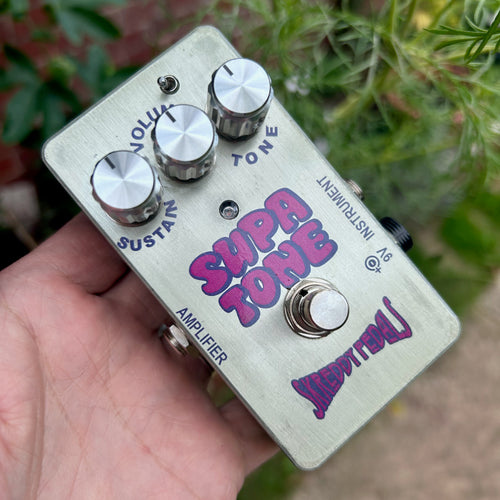Effect: Overdrive
“One of the most flexible fuzz units we have ever tested. The more the gain knob was turned up, the more responsive and dynamic the guitar’s volume knob became, almost serving as an extension of the pedal itself. With Cult’s gain at the three o’clock position and the guitar’s volume on 7, we got a great rhythm sound with enough clarity to allow open chords to bloom. Turning the guitar’s volume all the way up gave a very rich yet natural harmonic distortion that seemed to jump from the amp, different from other fuzz units that sort of compress the entire signal.” —Vintage Guitar magazine
When I delved into the germanium booster designs of the 1960s, I was astonished. How the hell did these electrifying, supremely dynamic circuits—so crucial to many of the era’s greatest recordings—fall into disuse? I studied every schematic and made dozens of clones. I felt like I’d been indoctrinated into some weird germanium cult. So when I developed my own take on those circuits, I named it Cult.
But Cult is no ’60s clone: It departs dramatically from the original ’60s circuits, providing fatter lows, fewer piercing highs, and more responsive dynamics. It just seems to “gush” more.
You probably know that 90% of today’s overdrives are related to a pedal whose name rhymes with Lube Reamer. These pedals employ an IC chip rather a discrete transistor. They compress your signal, making note attacks less prominent and limiting your dynamic range. The results are smooth and consistent—nothing wrong with that!
But Cult goes in the opposite direction, dramatically expanding your dynamic range. Note attacks crack like knuckles. Your phrases have an electrifying presence that seems to lunge from the speakers. When you hit the input hard, the bold, harmonically rich distortion maintains its edge, even in crowded musical contexts. Cult doesn’t go “squish.” It barks.
The dynamic response is simply astounding—you can go from crystalline to meltdown by touch and guitar knob settings alone. With your guitar volume rolled back, the tone is nearly indistinguishable from bypass, so you can literally leave Cult on all night and conjure a huge range of overdrive/distortion tones directly from your guitar.
Cult isn’t for everyone. If you’re looking for an overdrive to smooth out your sound for consistent, predictable results, run away! But if you’re the sort of player who likes sculpting sounds via touch and dynamics, or if you enjoy tones that walk the tightrope between clean and distorted, Cult can be a revelation.
Cult was created in San Francisco and is built in Michigan by skilled craftspeople earning a fair wage.
–Joe Gore, San Francisco
TO USE: Plug in with your guitar knobs at maximum, and use the single knob to set the maximum desired gain level. (I usually just floor it.) Then lower your guitar settings and soften your touch to explore the pedal’s extraordinary dynamic range. Try combining Cult with other drive and distortion effects—you’ll find that it layers beautifully.
CAUTIONS: One great thing about “Reamer” pedals is the way they provide solid distortion sounds even when the pedal’s output is turned down. Cult, on the other hand, works best when you whack your amp pretty hard. (That’s why it has no master volume control.) Cult probably isn’t a good choice if you want thick distortion at whisper volume.
Also, be sure to place Cult before any buffered devices in your effect chain. Placed post-buffer, the pedal can sound relatively thin and shrill. Cult almost always works best at or near the front of your chain. Fortunately, it sounds great driving downstream distortion pedals.




